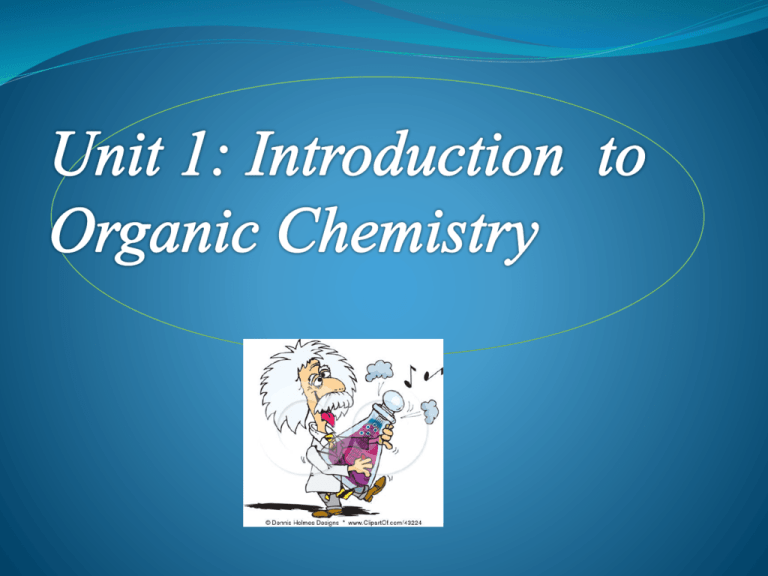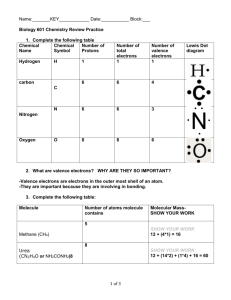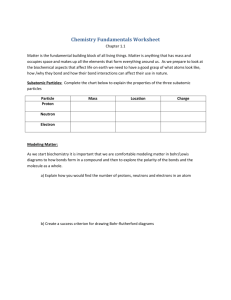
Organic Chemistry !"""
Organic chemistry is the
chemistry of the compounds of
carbon.
(Allotropic forms of carbon:
diamond, graphite, fullerenes.)
Inorganic Chemistry:The
chemistry of the other ~100
elements.
Allotropes
Allotropes are different forms of the same
element.
Different bonding arrangements between atoms
result in different structures with different
chemical and physical properties
Historical reason for division:
The sources of chemicals for early chemical
investigations (last quarter of 18th and first quarter of
19th centuries) were: animal, vegetable, mineral.
Organic chemicals, those from living organisms
(animal,vegetable) were complex and contained C, H,
and often N and/or O.
Inorganic chemicals (mineral) were simpler, could
contain a variety of elements, but only rarely carbon,
except for carbonates.
It seemed that inorganic sources of carbon
(carbonate,cyanide, carbon dioxide, etc.) could
not be converted into organic compounds.
This lead to the vital force theory.
Vital Force Theory: only living organisms
can convert carbon containing inorganic
compounds to organic compounds.
VITALISM – A BELIEF IN A LIFE FORCE THAT IS
OUTSIDE THE JURISDICTION OF CHEMICAL AND
PHYSICAL LAWS.
SCIENTISTS FEEL THAT THEY HAVE DISPROVED
VITALISM BY SYTHESIZING VARIOUS ORGANIC
COMPOUNDS IN A LAB
Friedrich Wöhler, 1828 -- Ammonium Cyanate ___heat_____> Urea
( an inorganic compound)
( organic compound)
Jon Jacob Berzelius 1807---- Coined
the term organic chemistry
Berzelius was interested in cases where
two different materials had the same
elemental composition and developed
the term isomerism to define it
1928 – FREDERICK WOHLER WAS ABLE TO
SYNTHESIZE UREA
HERMAN KOLBE – WAS ABLE TO SYNTHESIZE
ACETIC ACID
1953 – STANLEY MILLER HETEROTROPH
HYPOTHESIS: HYDROGEN, WATER, AMMONIA,
AND METHANE (RECREATE PRIMITIVE EARTH)
Organic chemicals make up
Foods and foodstuff
Flavours and fragrances
Medicines
Materials, polymers, plastics
Plant, animal and microbial matter; natural products
A vast range of manufactured goods
[pharmaceuticals, foods, dyestuffs, adhesives, coatings,
packaging, lubricants, cosmetics, films & fibres, etc. etc.]
Some organic chemicals
3 Main Concepts of organic
Chemistry
Stereochemistry
2. Functional groups
3. Curved arrow notation ( shows
1.
flow of electrons and where bonds form)
Reactivity in organic chemistry is based on flow of
electrons, if you understand where the electrons are
and where they are going then you can figure out how
a chemical reaction occurs.
Aspects of organic molecules
Structure & bonding
Chemical properties
• Atom to atom connectivity
• Transformation of molecular
• 3D shape (Stereochemistry)
Naming (Nomenclature)
structure (Reactions)
• How reactions occur
(Mechanism)
Physical properties
• Interaction with physical world
THE STRUCTURAL AND
FUNCTIONAL DIVERSTITY OF
ORGANIC MOLECULES IS THE
ABILITY OF CARBON TO
FORM LARGE COMPLEX
COMPOUNDS BY BONDING TO
ITSELF AND OTHER
ELEMENTS
VERSITILITY OF THE CARBON ATOM
ATOMIC NUMBER IS 6
4 VALENCE ELECTRONS
TETRAVALENT: In a tetrahedral molecular geometry
the carbon atom is located at the center with four
elements that are located at the corners. The bond angles
are 109.5°
COMPLETES THE OUTER SHELL BY FORMING 4 COVALENT
BONDS
MAKES LARGE COMPLEX MOLECULES POSSIBLE by forming
chains, branches or cyclic compounds
C
C
C
C
C
C
C
C
C
C
C
C
C
C
C
C
C
C C
3 Dimensional shape of the molecule has tetrahedral carbons
•Angle formed by any two bonds to any atom = ~ 109.5o
109.5
109.5
109.5
109.5
Need to be able to represent 3D molecular structure in 2D
Bond coming out of plane of screen
Bond going into plane of screen
Angle between any two bonds at a Carbon atom = 109.5o
H
H
H
C
H
H
C
H
109.5o
H
C
H
o
109.5
H
H
H
C
H
e.g.
H
=
H
H
C C
H
H
H
Or
HH
H
=
C C
HH
H
VARIATIONS OF ORGANIC MOLECULES
LENGTH
SHAPE
NUMBER AND LOCATION OF DOUBLE BONDS
OTHER ELEMENTS COVALENTLY BONDED TO
AVAILABLE SITES
HYDROCARBONS
HYDROGEN AND CARBON ONLY
STORE LARGE AMOUNTS OF ENERGY
MAJOR COMPONENT OF FOSSIL FUELS
MANY ORGANIC COMPOUNDS CONTAIN
REGIONS OF HYDROCARBON CHAINS
HYDROPHOBIC – C-C AND C-H, BONDS ARE
NON-POLAR
VERY DIVERSE IN STRUCTURE
Isomers
Isomers are organic molecules having the same chemical
formula but a different structural formula.
The animation above shows that atoms are rearranged in
the molecule to create different isomers. Butane has two
isomers.
Both butane and 2-methylpropane have the same
chemical formula but a different structural formula.
.
ISOMERS
COMPOUNDS WITH THE SAME MOLECULAR
FORMULA BUT DIFFERENT STRUCTURAL
FORMULA
CONSEQUENTLY – DIFFERENT PROPERTIES
THREE TYPES OF ISOMERS
STRUCTURAL ISOMER – VARIATION IN
COVALENT ARRANGEMENT OR MAY ALSO
DIFFER IN THE LOCATION OF DOUBLE BONDS
GEOMETRIC ISOMER
THE SAME COVALENT PARTNER BUT DIFFER IN
THE SPATIAL ARRANGEMENT AROUND THE
DOUBLE BOND. SUBTLE DIFFERENCE WILL
AFFECT BIOLOGICAL ACTIVITY
ENANTIOMERS
ISOMER THAT IS A MIRROR IMAGE OF ITSELF.
USSUALLY ONE WILL BE ACTIVE AND ONE
INACTIVE
CAN OCCUR WHEN 4 DIFFERENT ATOMS ARE
ATTACHED TO THE SAME (ASYMMETRIC)
CARBON
FUNCTIONAL GROUPS
CONTRIBUTE TO MOLECULAR DIVERSTIY
SPECIFIC CHEMICAL AND PHYSICAL
PROPERTIES
USSUALLY CHEMICALLY ACTIVE
CONSISTENT BEHAVIOR FROM ONE ORGANIC
MOLECULE TO ANOTHER
DETERMINES THE UNIQUE PROPERTIES OF
AN ORGANIC MOLECULE
The Main Functional Groups
Copyright © Houghton Mifflin
Company. All rights reserved.
1 | 32
Structure of the Atom
Atoms consist of: Protons (+) ( atomic number)
Neutrons (neutral)
Electrons (-)
Protons and neutrons are in the nucleus and have similar
masses (p + n = atomic weight)
Atoms with the same number of protons but different neutrons
are called ISOTOPES. E.g. 12C (major isotope)
13C (~1%, used in carbon NMR) ( nuclear magnetic resonance)
14C (radioactive, used in Carbon dating)
Almost all the mass of an atom is in the nucleus, but it is the
electrons that are involved in the chemical bonding and
reactions of an atom.
Electronic Structure of the Atom
Electrons are located in orbitals around a nucleus, but the
Heisenberg Uncertainty Principle tells us that we cannot
pinpoint exactly where the electron is.
So we use the term ELECTRON DENSITY, which is the
probability of finding the electron in a particular part of
the orbital.
ORBITAL: is an allowed energy state for an electron, with
an associated probability function that defines the
distribution of electron density in space.
Electronic Configuration of Atoms
The Aufbau Principle tells us how to ‘build up’ a ground
state (most stable) configuration, which is to fill the
orbitals in order, until the correct number of electrons
have been added.
Hund’s rule states that when there are two or more
degenerate orbitals available, electrons would rather go
into different orbitals rather than the same one.
Electron Arrangements of the First 18
elements
Copyright © Houghton Mifflin Company. All rights reserved.
1 | 36
valence electrons
The valence electrons are those in the outermost shell.
(Periodic group number is the number of valence
electrons).
Valence Electrons of the First 18 Elements
reserved.
1 | 38
Bonding
Atoms transfer or share electrons in such a way as to
attain a filled shell of electrons – The OCTET rule.
A filled shell is also known as a noble gas configuration.
Ionic Bonding
The transfer of one or more electrons from one atom to
another. (loss or gain of electrons) ( between metal and
nonmetal) ( when the substance dissolves, the ions
separate and are able to move about in solution relatively
freely)
Electropositive (cation) gives up an electron
Electronegative (anion) accepts the electron
Na+ …… Cl-
Covalent Bonding
The electrons are shared, not transferred. ( between
nonmetals)
H• + H• → H:H
Covalent is the most important bonding in Organic
Chemistry.
Lewis Structures
Each electron is represented by a dot.
A pair of electrons by two dots, or a dash.(showing a bond
has occurred)
Non bonding pairs of electrons
Also known as lone pairs
Lone pairs often dictate a molecule’s reactivity.
Multiple Bonds
The sharing of one pair of electrons is a single bond.
The sharing of two pairs gives a double bond.
The sharing of three pairs gives a triple bond
In neutral organic compounds:
Carbon forms four bonds
Nitrogen forms three bonds (and a lone pair)
Oxygen forms two bonds
A covalent bond, where the electrons are shared equally is
called a non-polar bond. (E.g. H-H)
Bonds between different atoms usually result in the
electrons being attracted to one atom more strongly than
the other. Such an unequal sharing of the pair of bonding
electrons results in a POLAR bond.
This competition for electron density is scaled by
ELECTRONEGATIVITY values.
Elements with higher electronegativity values have greater
attraction for bonding electrons
Electronegativity group trends: elements become less
electronegative as move down a group on the periodic table
Polar Covalent bonds
Most reactivity relates here.
They still have octet ( 8 valence electrons) but
not sharing the electrons equally.
This gives rise to lots of reactivity in organic
chemistry.
Ex H-F unequal sharing of electrons.. so polar covalent
Reason: F is more electronegative than H ( F= 4.0 and H
= 2.2)
So electrons spend more time with F so F is partially
negative and H is partially positive
Delta = partial
H-F H= delta + and F = delta –
The electronegativity of carbon is 2.5 and Hydrogen is 2.2
so together they are non polar
Ionic, covalent ( polar and nonpolar) depends on
electronegativity
Electronegativity
A good measure of polar covalent bond or ionic
bond.
Polar covalent bonds have an electronegativity
difference less than 2 (1.5)
Ionic bonds have an electronegativity
difference greater than 2 (1.5)
Nonpolar bonds: have an electronegativity
difference less than 0.5
Electronegativities of Some
Common Elements
Copyright © Houghton Mifflin
Company. All rights reserved.
1 | 49
Electronegativity
Pauling Scale
Trends are for electronegativity to
decrease down the periodic table and
increase across the table.
Ex NaCl Na=.9 Cl = 3.4 greater than 2 so ionic
Ex HF
H=2.2 F =4.0 less than 2 so polar
So what if we have a bond between carbon and
oxygen
Carbon is less electronegative than oxygen so
carbon has a partial positive charge (delta +)
and O has a partial negative charge (delta-)
Valences of Common Electrons
The valence of an element is the number of bonds that
atom of the element can form. The valence applies to
whether the bonds are single double or triple
Resonance structures
Are 2 or more structures with identical arrangements of
the atoms but different arrangements of the electrons.
The true structure of the molecule is a hybrid of the
resonance structures
We use double headed arrows between contributing
structures to distinguish resonance from an equilibrium
reaction which uses reversable arrows
Abbreviated Structural Formulas:
1. Full structural formula: example for octane…Can also do shortcuts:
CH3-(CH2 -CH3
H H H H H H H H
H C C C C C C C C H
H H H H H H H H
2. Condensed structural formula.
CH3 CH2 CH2 CH2 CH2 CH2 CH2 CH3
3. Line segment structural formula
Line segment structural formula for
octane
•Each line represents a covalent bond between atoms
•Unless indicated otherwise, assume bonds are between Carbons
•C-H bonds not shown, assume they are present
•[so as make up valency of Carbon to 4]
O
=
H H
H H
H C C O C C H
H H
H H
=
=
etc.
=
pentane
Arrow Formalism
Arrows in chemical drawings have specific meanings.
1. Curved arrows: used to show how electrons are moved
in resonance structures and in reactions
Curved arrow Notation
A curved arrow with half a head is called a fishhook. And
indicates the movement of single electrons, two fishhooks
are used to show the movement of two electrons
Straight arrows point from reactant to product in the
chemical reaction equation
Double headed straight arrows indicate resonance
structures
Atomic Orbitals
These are different shells at differing distances away from
the nucleus. Each has a principal quantum number (n).
As n increases, Shells are further from the nucleus
Higher energy
Can hold more electrons
n=1 can hold 2 electrons, n=2 can hold 8 electrons
Each orbital contains a maximum of 2 electrons. The
orbitals with different shapes are designed by letters s, p,
and d
In addition the orbitals are grouped in shells designated by
the numbers 1,2,3 ect..
Each shell contains differnet types and numbers of
orbitals, corresponding to the shell number.
Ex shell 1 has 1s, shell 2 has 2s, 2d, shell 3 has 3s, 3p 3d
ect
Numbers of Orbitals and electrons in the
First Three Shells
An sp3 orbital extends mainly in one direction from the nucleus and
forms bonds with other atoms in that direction.
It is a p shaped orbital that is one part s and three parts p in
character
Carbon sp3 orbitals can overlap with Hydrogen 1s orbitals to form Carbon-Hydrogen s
bonds
=
H
H
H
C C
H
H
H
Each sp3 orbital contributes one electron; each s orbital contributes one electron to form
C-H [C..H]
[Anti-bonding orbitals also formed; not occupied by electrons]
s bonds: symmetrical about the bond axis
Geometry of Carbon in ethane is tetrahedral and is based upon sp3 hybridisation
sp3 hybridised Carbon = tetrahedral Carbon
Tetrahedral angle 109.5o
109.5o
C
H
H
H
C C
H
H
This represents a particular orientation of the C-H
bonds on adjacent Carbons
H
Ethane
H
H
H
View along C-C bond:
H
H
H
Newman projection
Can select one C-H bond on either carbon and
define a dihedral angle or torsional angle (φ)
φ
H
H
H
H
H
H
φ =
H
H
H
60o
H
H
Staggered conformation
Minimum energy conformation
(least crowded possible conformation)
H
C-C s bonds: symmetrical about the bond axes.
In principle, no barrier to rotation about C-C bond
HH
Could have
H
φ = 0o
=
H
H
H
H
Eclipsed conformation
Maximum energy conformation
(most crowded possible conformation)
H
H
C C
H
H
H
•Eclipsed conformation experiences steric hindrance
•Unfavourable interaction between groups which are close together in space
HH
Steric hindrance exists between the eclipsing C-
H bonds in this conformation
H
H
H
H
•These unfavourable interactions absent in the staggered conformation
•Hence, the staggered conformation is lower in energy
•Energy difference between eclipsed and staggered conformations of ethane = 12 kJ mol1
•Each C-H eclipsing interaction contributes 4 kJ mol-1 of torsional strain energy
-1
4 kJ mol
HH
-1
4 kJ mol
Conformations:
H
H
Total: 12 kJ mol-1 torsional strain
H
H
-1
4 kJ mol
different orientations of molecules
arising from rotations about C-C
s bonds
Consider one full rotation about the C-C bond in ethane
Start at
φ = 0 (eclipsed conformation)
HH
Eclipsed conformation
strain energy 12 kJ mol-1
φ = 0
H
H
H
H
Rotate 60
H
φ = 60
H
H
H
H
Staggered conformation
strain energy 0 kJ mol-1
H
Rotate 60
HH
Eclipsed conformation
strain energy 12 kJ mol-1
φ = 120
H
H
H
H
Various Structural diagrams:
1. Ball and Stick Representations: emphasizes the
bonds that connect atoms
Copyright © Houghton Mifflin
Company. All rights reserved.
1 | 74
2. space-filling models: showing the
approximate volume of the entire molecule
Copyright © Houghton Mifflin
Company. All rights reserved.
1 | 75
3. Electrostatic potential (ESP) view: shows
distribution of electrons in a molecule, red=
neg charge, blue = positive charge
Copyright © Houghton Mifflin
Company. All rights reserved.
1 | 76
Classification According to molecular framework:
.1. Acyclic: not cyclic, chains of carbon but no rings
Copyright © Houghton Mifflin
Company. All rights reserved.
1 | 77
2. carbocyclic compounds with rings of various
sizes and shapes
Copyright © Houghton Mifflin
Company. All rights reserved.
.
1 | 78
3. heterocyclic compounds having a variety of
heteroatoms and ring sizes.
Copyright © Houghton Mifflin
Company. All rights reserved.
1 | 79






